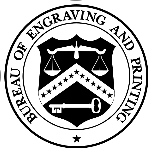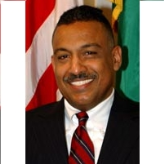The new site began producing currency in January 1991 and opened officially on April 26 of that same year. It joins the original facility in Washington, DC, to make BEP the largest producer of United States government security documents.
The BEP is also responsible for advising other federal agencies on matters of document security. The agency processes claims for the redemption of mutilated currency and uses its research and development efforts to focus on the continued use of automation in the production and counterfeit deterrence process for security documents.
|
Crane & Co., Inc.
|
$958,892,275
|
|
Sicpa Holding, SA
|
$258,689,738
|
|
WPP Group PLC
|
$74,320,397
|
|
Koenig & Bauer AG
|
$65,549,650
|
|
Haws & Tingle General Contractors, Inc.
|
$32,690,418
|
|
De La Rue Giori SA
|
$32,119,000
|
|
Raven Services Corporation
|
$27,823,597
|
|
Frank Parsons Paper Company, Inc.
|
$24,826,020
|
|
Electronic Systems Services, Inc.
|
$23,839,349
|
|
C & E Services, Inc.
|
$21,333,161
|
is a leading manufacturer of fiber and paper products, as well as other subsidiary businesses. As the BEP’s largest contractor, they produce the paper US currency is printed on.
, the agency’s second largest contractor, is a company providing security inks and integrated security systems for banknotes, documents of value and consumer goods.
“In God We Trust” marks 50 years on paper money
(by Millete Birhanemaskel, Knoxville News Sentinel)
$100 Bill to Get Facelift, Added Security (by Martin Crutsinger, Associated Press)
- Table of Contents
- Overview
- History
- What it Does
- Where Does the Money Go
- Controversies
- Suggested Reforms
- Comments
- Leave a comment


Leonard R. Olijar became the director of the Bureau of Engraving and Printing (BEP) in May 2015, after serving as BEP’s deputy director starting in January 2013. Located in the Treasury Department, BEP is responsible for printing U.S. currency (but not minting coins) and a variety of government documents, including Treasury securities, identification cards and naturalization certificates. BEP also decides whether mutilated currency can be salvaged for use or destroyed.
Born in September 1959, Leonard Richard Olijar grew up in a large family of seven children in Lower Burrell, Pennsylvania, a small town in the Allegheny-Kiski Valley about 23 miles northeast of Pittsburgh. After graduating Burrell High School in 1976, Olijar became the first person in his family to graduate college, earning a B.S. in Forest Products at Penn State University in 1980. After working a few jobs, Olijar returned to school and earned an accounting degree at the University of Colorado-Denver in 1987.
Olijar has worked at BEP for 29 years, beginning his career in 1988 as a systems accountant implementing BEP’s first Enterprise Resource Planning system. Over the years, he rose gradually through the Bureau.
In 2006, Olijar became BEP’s chief financial officer. He initiated the performance of BEP-wide risk assessments and began the implementation of a Lean Six Sigma program to improve customer service and efficiency.
In 2012, Olijar served as the executive sponsor for BEP’s Best Place to Work initiative and the BEP was recognized as one of the most improved agencies.
Olijar resides in Centreville, Virginia, with his wife, Suzanne, with whom he has two daughters, Valerie and Sarah.
-Matt Bewig
To Learn More:
Lower Burrell Native Oversees U.S. Currency Printing Process (by Emily Balser, Greensburg Tribune-Review)
Agency of the Month Treasury Department: Leonard Olijar (Federal News Radio) (audio)

- Latest News
- D.C. Public Schools will Teach all Second-Graders to Ride a Bike
- New Rule in Germany Limits Sales of Sex-Themed E-Books to 10pm to 6am
- What Happened to the 6-Year-Old Tibetan Boy the Chinese Government Kidnapped 20 Years Ago?
- U.S. Ambassador to Turkey Photoshops his Hair Color to Mock Turkish Mayor
- Mystery Artist Calls Attention to Unfixed Potholes by Drawing Penises around Them
The new site began producing currency in January 1991 and opened officially on April 26 of that same year. It joins the original facility in Washington, DC, to make BEP the largest producer of United States government security documents.
The BEP is also responsible for advising other federal agencies on matters of document security. The agency processes claims for the redemption of mutilated currency and uses its research and development efforts to focus on the continued use of automation in the production and counterfeit deterrence process for security documents.
|
Crane & Co., Inc.
|
$958,892,275
|
|
Sicpa Holding, SA
|
$258,689,738
|
|
WPP Group PLC
|
$74,320,397
|
|
Koenig & Bauer AG
|
$65,549,650
|
|
Haws & Tingle General Contractors, Inc.
|
$32,690,418
|
|
De La Rue Giori SA
|
$32,119,000
|
|
Raven Services Corporation
|
$27,823,597
|
|
Frank Parsons Paper Company, Inc.
|
$24,826,020
|
|
Electronic Systems Services, Inc.
|
$23,839,349
|
|
C & E Services, Inc.
|
$21,333,161
|
is a leading manufacturer of fiber and paper products, as well as other subsidiary businesses. As the BEP’s largest contractor, they produce the paper US currency is printed on.
, the agency’s second largest contractor, is a company providing security inks and integrated security systems for banknotes, documents of value and consumer goods.
“In God We Trust” marks 50 years on paper money
(by Millete Birhanemaskel, Knoxville News Sentinel)
$100 Bill to Get Facelift, Added Security (by Martin Crutsinger, Associated Press)
Comments


Leonard R. Olijar became the director of the Bureau of Engraving and Printing (BEP) in May 2015, after serving as BEP’s deputy director starting in January 2013. Located in the Treasury Department, BEP is responsible for printing U.S. currency (but not minting coins) and a variety of government documents, including Treasury securities, identification cards and naturalization certificates. BEP also decides whether mutilated currency can be salvaged for use or destroyed.
Born in September 1959, Leonard Richard Olijar grew up in a large family of seven children in Lower Burrell, Pennsylvania, a small town in the Allegheny-Kiski Valley about 23 miles northeast of Pittsburgh. After graduating Burrell High School in 1976, Olijar became the first person in his family to graduate college, earning a B.S. in Forest Products at Penn State University in 1980. After working a few jobs, Olijar returned to school and earned an accounting degree at the University of Colorado-Denver in 1987.
Olijar has worked at BEP for 29 years, beginning his career in 1988 as a systems accountant implementing BEP’s first Enterprise Resource Planning system. Over the years, he rose gradually through the Bureau.
In 2006, Olijar became BEP’s chief financial officer. He initiated the performance of BEP-wide risk assessments and began the implementation of a Lean Six Sigma program to improve customer service and efficiency.
In 2012, Olijar served as the executive sponsor for BEP’s Best Place to Work initiative and the BEP was recognized as one of the most improved agencies.
Olijar resides in Centreville, Virginia, with his wife, Suzanne, with whom he has two daughters, Valerie and Sarah.
-Matt Bewig
To Learn More:
Lower Burrell Native Oversees U.S. Currency Printing Process (by Emily Balser, Greensburg Tribune-Review)
Agency of the Month Treasury Department: Leonard Olijar (Federal News Radio) (audio)

- Latest News
- D.C. Public Schools will Teach all Second-Graders to Ride a Bike
- New Rule in Germany Limits Sales of Sex-Themed E-Books to 10pm to 6am
- What Happened to the 6-Year-Old Tibetan Boy the Chinese Government Kidnapped 20 Years Ago?
- U.S. Ambassador to Turkey Photoshops his Hair Color to Mock Turkish Mayor
- Mystery Artist Calls Attention to Unfixed Potholes by Drawing Penises around Them





Comments